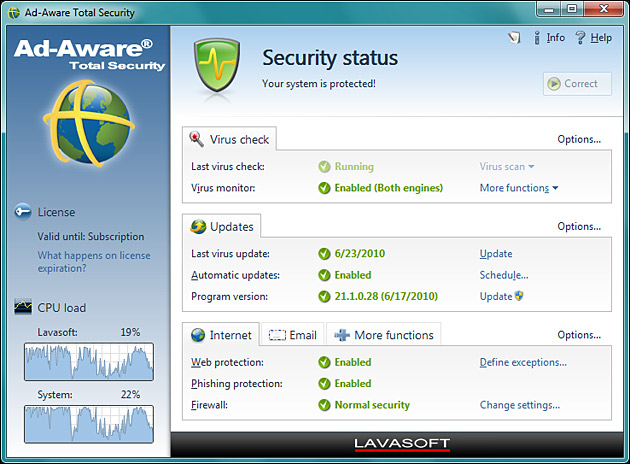The trend is for antivirus programs to add spam filtering, firewalls, etc., eventually being marketed as security suites. This is usually done by just adding more features to the existing program. Ad-Aware Total Security 1.0, new from Lavasoft, takes a different approach. Most of its features are from G Data, Lavasoft’s partner in technology.
The suite itself is massive, taking up more than a gigabyte of hard disk space after install. By comparison, Norton 360 uses 250 megabytes, and Norton 360 less than 200 megabytes. Because of the size, you can expect installation to be a lengthy process.
The main screen of Ad-Aware shows the usual status indicator in green, yellow or red, and a button for fixing problems. CPU usage is shown by the overall system as well as by Ad-Aware’s components. Components of the main protection have panels showing details of status, as well as links for changing configuration or taking action.
In tests, Ad-Aware dealt satisfactorily with Internet-based tests such as port scans. All ports were correctly set to stealth mode, making the system invisible to external attack.
With many firewalls, you get constant queries about whether specific connections and levels of access required should be permitted, which can get rather confusing. Some firewalls handle this by incorporating a training mode that sets up rules. This prevents the constant popups, but with the drawback that when training mode is active, any pre-existing malware has unlimited access.
Ad-Aware does things differently. In Autopilot mode, which is the default, it sets up rules for allowing and denying without any user participation. While useful, though, it doesn’t seem to be completely reliable.
When Ad-Aware is first installed, it creates automatic firewall rules for a number of well-known programs, such as browsers. During tests, it suddenly started blocking Firefox – which tech support determined was the result of blocking malware that launched Firefox. Guilty by association, indeed.
The firewall can’t be disabled by editing the registry, or via the Task Manager (though the user interface can be closed). The essential services of the suite are also protected so that they can’t be disabled by malware. Unfortunately, there’s a gap in their defenses – their startup type could be set to ‘disabled’ by malware, and the system then rebooted and crashed, resulting in no protection.
POP3 e-mail is filtered by the antispam module in Ad-Aware, and subject lines are modified in the case of spam or suspicious mail. For those using Outlook, these messages are autimatically sent to a folder created for this purpose; users of different mail clients will need to set up a rule themselves. Mail written in specific languages have a marker added to them.
In tests with the mail filter active, downloading from spam-infested accounts took a bit more than double the usual time. No valid personal mail was blocked, though three quarters of all newsletters landed up in the spam folder and, regrettably, a third of the spam made it into the inbox.



